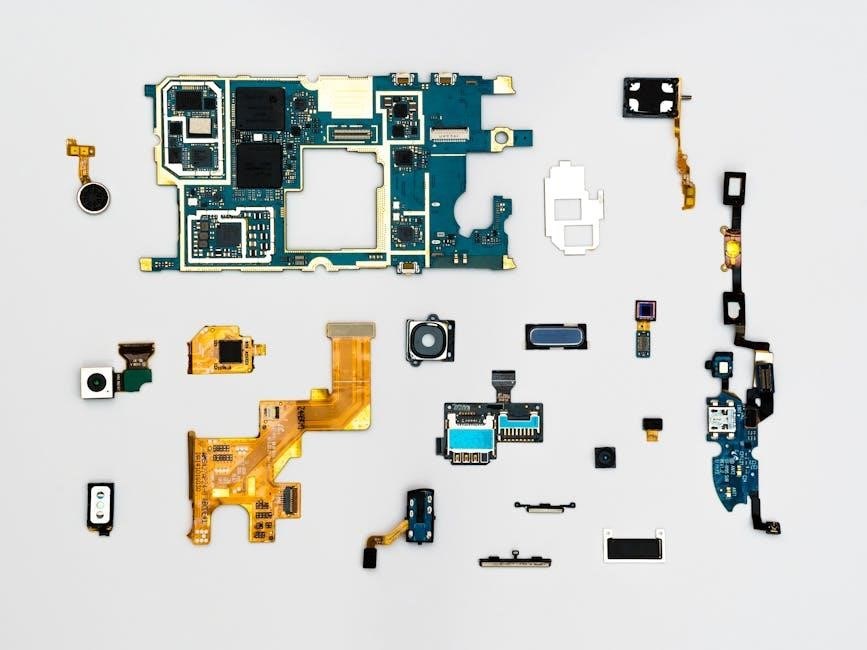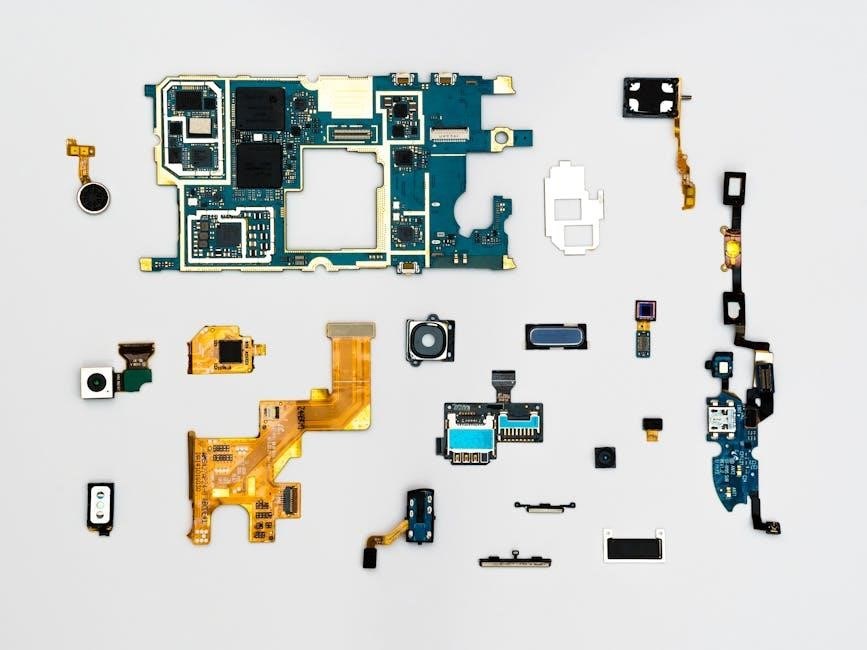The MMSE‚ developed by Folstein et al. in 1975‚ is a 30-point cognitive screening tool used globally to assess dementia and cognitive impairment in clinical settings.
1.1 Historical Development of the MMSE
The Mini-Mental State Examination (MMSE) was first introduced by Folstein et al. in 1975 as a practical method to assess cognitive impairment in clinical settings. Initially designed for grading the cognitive state of patients‚ it gained widespread acceptance due to its simplicity and effectiveness. Over the years‚ the MMSE has undergone various validations and adaptations to suit diverse populations‚ making it a cornerstone in dementia screening and cognitive assessments. Its development marked a significant advancement in neurology and psychiatry‚ providing a standardized tool for early detection and monitoring of cognitive decline.
1.2 Purpose and Significance of the MMSE
The MMSE serves as a widely used screening tool for detecting cognitive impairment and monitoring dementia progression. Its primary purpose is to assess memory‚ attention‚ language‚ and orientation‚ providing insights into cognitive function. The test’s brevity and ease of administration make it a valuable resource for clinicians in various settings. By identifying early signs of cognitive decline‚ the MMSE aids in timely interventions and tailored treatment plans. Its significance lies in its ability to track changes over time‚ making it indispensable in both clinical practice and research‚ while also guiding healthcare providers in delivering appropriate patient care.

Structure of the Mini-Mental State Examination
The MMSE is an 11-question assessment evaluating orientation‚ registration‚ attention‚ recall‚ and language. Each section targets specific cognitive functions‚ providing a comprehensive overview of mental status.
2.1 Cognitive Domains Assessed by the MMSE
The MMSE evaluates five primary cognitive domains: orientation‚ registration‚ attention and calculation‚ recall‚ and language. Orientation assesses awareness of time‚ place‚ and person. Registration tests the ability to repeat named prompts. Attention and calculation measure arithmetic skills‚ while recall evaluates memory retention. Language is assessed through naming‚ repetition‚ and sentence composition. These domains provide a structured approach to identifying cognitive impairments‚ ensuring a comprehensive evaluation of mental status.
2.2 Orientation
The MMSE’s orientation section assesses a patient’s awareness of time‚ place‚ and person. Questions include the current date‚ season‚ year‚ day‚ country‚ state‚ city‚ location‚ and floor. This domain evaluates temporal and spatial awareness‚ crucial for diagnosing disorientation‚ often seen in cognitive impairments. Scoring is based on correct answers‚ with a maximum of 10 points. Accurate responses indicate intact orientation‚ while errors may suggest cognitive dysfunction. This section is fundamental in the initial assessment of mental status and helps clinicians gauge the severity of cognitive decline‚ particularly in conditions like dementia or delirium.
2.3 Registration
Registration assesses short-term memory and attention by asking the patient to repeat three unrelated words. The examiner states the words clearly and slowly‚ and the patient must recall them immediately. This section evaluates the ability to register new information‚ a fundamental cognitive function. Scoring ranges from 0 to 3 points‚ with one point awarded for each correct word. Errors may indicate deficits in attention or memory‚ common in early stages of cognitive impairment. This simple yet effective task provides insights into the patient’s ability to process and retain information‚ making it a critical component of the MMSE.
2.4 Attention and Calculation
This section evaluates the patient’s ability to focus and perform mental arithmetic‚ essential for daily functioning. The MMSE includes tasks such as spelling “world” backward and subtracting sevens from 100. These exercises test working memory‚ concentration‚ and cognitive flexibility. The patient’s ability to complete these tasks accurately and efficiently is scored‚ with a maximum of 5 points. This assessment helps identify deficits in attention and calculation‚ which are common in individuals with cognitive impairment. It provides clinicians with valuable insights into the patient’s mental processing capabilities. The results are interpreted alongside other MMSE sections for a comprehensive cognitive evaluation.
2.5 Recall
The recall section of the MMSE assesses memory by asking the patient to remember and repeat three unrelated objects named by the examiner. This task evaluates short-term memory and the ability to retain information. The patient is scored based on the number of objects correctly recalled‚ with a maximum of 3 points. Difficulty in recalling these items may indicate cognitive impairment or memory deficits‚ which are often associated with conditions like dementia. This section is crucial for understanding the patient’s ability to form and retrieve new memories‚ providing valuable insights into their cognitive function and potential neurological conditions.
2.6 Language
The language section of the MMSE evaluates verbal and comprehension abilities. Patients are asked to name simple objects (e.g.‚ pencil‚ watch)‚ repeat a sentence (“No ifs‚ ands‚ or buts”)‚ and read a command (e.g.‚ “Close your eyes”). They are also assessed on their ability to write a sentence and draw a shape‚ like a polygon. This section tests for aphasia or other language-related impairments‚ which are common in dementia. The tasks are scored based on accuracy‚ with a maximum of 8 points. Difficulty in these areas may indicate significant cognitive or neurological issues.
2.7 Copying
The copying section of the MMSE assesses visuospatial and constructional abilities by asking the patient to draw a specific geometric shape‚ such as a five-pointed star or a pentagon. This task evaluates the ability to replicate complex figures accurately. The examiner provides a model‚ and the patient’s drawing is scored based on accuracy and completeness. This section helps identify visuospatial deficits‚ which are common in dementia. The task is simple but sensitive‚ offering insights into the patient’s cognitive and motor functions. It is a quick yet effective measure of neurological integrity and spatial reasoning. The score reflects the patient’s ability to follow visual instructions and replicate patterns.

Administration and Scoring Guidelines
The MMSE is administered in approximately 10 minutes‚ consisting of 30 points. Scores range from 0 to 30‚ with higher scores indicating better cognitive function. Scores below 24 suggest cognitive impairment.
3.1 Instructions for Administering the MMSE
The MMSE is typically administered in a quiet‚ distraction-free environment. The examiner should sit facing the patient and ensure they are comfortable. Instructions must be clear and concise‚ using simple language. Each question or task should be asked a maximum of three times. The test includes tasks such as naming objects‚ repeating phrases‚ drawing a clock‚ and writing a sentence. Scorers must award one point for each correct response‚ with no penalties for incorrect answers. The examiner should avoid leading questions and maintain a neutral tone throughout the assessment. Proper administration ensures accurate and reliable results.
3.2 Scoring System and Interpretation
The MMSE is scored out of 30‚ with higher scores indicating better cognitive function. A score of 24 or above typically suggests no cognitive impairment‚ while scores below 24 may indicate impairment. Specifically‚ scores of 18-23 suggest mild impairment‚ 12-17 moderate impairment‚ and below 12 severe impairment. The test evaluates various cognitive domains‚ and scores are interpreted based on norms adjusted for age and education. Interpretation must consider cultural and sociodemographic factors‚ as these can influence results. The MMSE is not diagnostic but serves as a screening tool to guide further evaluation. Accurate scoring is essential for reliable interpretation.

Clinical Applications of the MMSE
The MMSE is widely used to screen for cognitive impairment‚ monitor dementia progression‚ and assess mental status in clinical settings‚ serving as a practical tool for clinicians globally.
4.1 Screening for Cognitive Impairment
The MMSE is a widely used tool for detecting cognitive impairment‚ particularly in older adults. It assesses various cognitive domains‚ including orientation‚ registration‚ attention‚ recall‚ and language. By identifying individuals with potential cognitive deficits‚ the MMSE serves as a first-step screening instrument. Its simplicity and brevity make it an effective method for early detection of dementia or other cognitive disorders. The test helps differentiate between normal cognitive aging and pathological conditions‚ guiding further diagnostic evaluations. This makes the MMSE a valuable asset in both clinical and research settings for identifying individuals who may require comprehensive cognitive assessments.
4.2 Monitoring Dementia Progression
The MMSE is extensively used to monitor the progression of dementia‚ enabling clinicians to track cognitive changes over time. Serial assessments help identify declines in cognitive function‚ such as memory loss or language difficulties. The test’s scoring system provides a clear measure of cognitive impairment severity‚ allowing healthcare providers to evaluate disease progression and adjust treatment plans accordingly. While the MMSE is not diagnostic on its own‚ it serves as a valuable tool for longitudinal monitoring‚ offering insights into the effectiveness of interventions and supporting personalized care strategies for patients with dementia.

Limitations and Criticisms of the MMSE
The MMSE has cultural and educational biases‚ affecting scores in diverse populations. It also lacks depth in assessing certain cognitive functions and is insufficient for definitive diagnosis.
5.1 Cultural and Sociodemographic Biases
The MMSE exhibits cultural and sociodemographic biases‚ as it was primarily developed for Western‚ educated populations. This limits its accuracy in diverse cultural contexts‚ particularly for individuals with lower educational backgrounds or non-English speakers. The test’s reliance on tasks like drawing a clock or understanding specific language constructs may not be universally applicable. Additionally‚ cultural differences in communication styles and problem-solving strategies can influence scores. These biases highlight the need for cautious interpretation and the importance of supplementing the MMSE with other diagnostic tools to ensure equitable assessment across all populations.
5.2 Overreliance on the MMSE for Diagnosis
The MMSE is widely used but should not be the sole diagnostic tool for cognitive impairment. While it provides a general cognitive snapshot‚ it lacks the sensitivity to detect mild cognitive impairment (MCI) or early dementia stages. Overreliance on the MMSE can lead to misdiagnoses‚ as it does not account for cultural‚ educational‚ or linguistic differences. Additional assessments‚ such as neuropsychological tests and clinical evaluations‚ are essential for accurate diagnoses. Relying exclusively on the MMSE may overlook subtle cognitive deficits‚ underscoring the need for a comprehensive diagnostic approach in clinical practice to ensure reliable and valid results.
The Mini-Mental State Examination (MMSE) remains a widely used and valuable tool for assessing cognitive function and detecting dementia. Its simplicity and brevity make it a practical screening instrument in clinical and research settings. However‚ its limitations‚ such as cultural biases and insufficient sensitivity for mild cognitive impairment‚ highlight the need for complementary assessments. While the MMSE is effective for initial cognitive screening‚ it should not be relied upon as the sole diagnostic measure. Its role in early detection and monitoring underscores its importance‚ but a comprehensive diagnostic approach is essential for accurate patient care and management.








































































